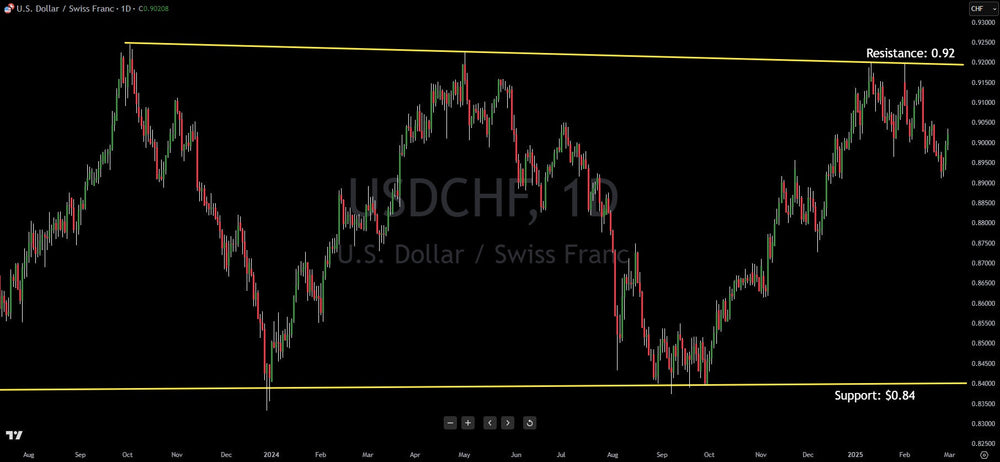Range Trading The USD/CHF (U.S Dollar/Swiss Franc)

The USD/CHF currency pair has established a well-defined, long-term trading range between 0.84 and 0.92, a pattern that has persisted for over two years. This extended period of consolidation suggests a significant accumulation or distribution phase, where market participants are grappling with underlying economic and geopolitical factors influencing both the U.S. dollar and the Swiss franc.
Factors Contributing to the Range-Bound Behavior:
- Economic Divergence and Convergence: The range could be attributed to the fluctuating relative strength of the U.S. and Swiss economies. Factors like interest rate differentials, inflation rates, and GDP growth influence currency valuations. Periods of perceived convergence may reinforce the range, while growing divergence could trigger a breakout.
- Safe-Haven Status of the Swiss Franc: The Swiss franc is traditionally considered a safe-haven currency, attracting investment during times of global uncertainty. This characteristic can strengthen the franc, particularly during periods of geopolitical instability or financial market volatility, and therefore contribute to the bottom support of the range.
- Monetary Policy: The Swiss National Bank (SNB) and the Federal Reserve's monetary policies play a crucial role. Their respective decisions on interest rates, quantitative easing, or other interventions can significantly impact the USD/CHF exchange rate.
- Market Sentiment: Global risk sentiment and investor appetite for risk influence the demand for both currencies.
Trading Strategies for the Range:
Given the extended duration of the range, it is reasonable to expect it to persist for several more months, or even another year or two. However, the longer a range holds, the more powerful the potential breakout.
Breakout Strategy:
- The most prudent approach is to anticipate a breakout. A decisive break above 0.92, accompanied by strong volume, would signal a potential bullish trend. Conversely, a clear break below 0.84, also with significant volume, would indicate a potential bearish trend.
- Traders should wait for a confirmed breakout, meaning price action that clearly breaches the range boundaries and holds. False breakouts are common in range-bound markets.
Range Trading Strategy (with caution):
- While waiting for a breakout, traders can attempt to capitalize on the range by shorting near the 0.92 resistance level and buying near the 0.84 support level.
- However, this strategy carries significant risk due to the potential for a sudden breakout. Therefore, strict risk management is crucial.
-
Risk Management:
- Implement tight stop-loss orders just outside the range boundaries to limit potential losses.
- When shorting near 0.92, place a stop-loss just above it. If the price breaks above, trigger the stop-loss and consider reversing to a long position.
- The same principle applies for long positions near 0.84, placing stop losses just below that level.
- Consider using appropriate position sizing to manage risk.
- Volume confirmation is key. High volume on a break of either level adds validity to the move.
Anticipating the Breakout:
- Keep a close watch on economic data releases from both the U.S. and Switzerland, as well as any major geopolitical events that could impact the currencies.
- Monitor central bank announcements and speeches for clues about future monetary policy decisions.
- Pay attention to technical indicators, such as moving averages and relative strength index (RSI), to identify potential momentum shifts.
In conclusion, the USD/CHF's prolonged range presents both opportunities and risks. A patient, disciplined approach, with a focus on risk management, is essential for navigating this market.
Trading involves substantial risk. All content is for educational purposes only and should not be considered financial advice or recommendations to buy or sell any asset. Read full terms of service.




